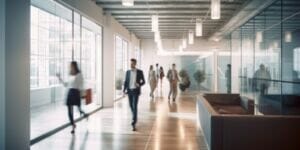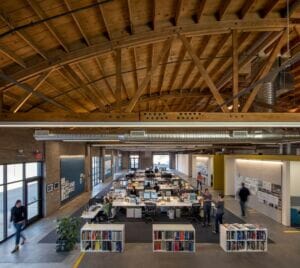As 2019 draws to a close, the experts at COMMERCIALCafé decided to take a look at some of the most popular commercial interior design trends and have an in-depth discussion with several interior design experts.
Every year, innovations in architecture shift the focus of interior design, morphing it by focusing on the experience of the space, rather than the need it fulfills. Offices are no longer a place where people can do their job, but one that they enjoy spending time in and that helps them be productive and creative.
Sustainability and environmental awareness have set the tone in 2020, and likely beyond. Companies are shifting their preferences accordingly by implementing more eco-friendly policies, green spaces, and innovative materials into their workspaces. These innovations also help to address employee health and wellbeing, which is an increasingly important goal for companies going forward.
Most of all, interior design is distancing itself from the cold and clinical feel of classic office spaces; instead, designers strive to make office spaces welcoming and homely, turning the design of office spaces towards comfort.
• Kellie Sirna, Principal and Co-Founder of Studio 11 Design: As Principal and Co-Founder of Studio 11 Design, Kellie Sirna’s entrepreneurial acumen and creative perspective has been honed throughout two decades of traveling the world and designing some of the hospitality industry’s most inspiring spaces. Since starting the firm with Co-Founder Stacy Elliston in 2011, Kellie has led global projects across boutique and renown nameplates such as Caesars Entertainment, Hyatt, Starwood, Thompson Hotels and many more.
• Jenifer Halverson, Studio Director at Pacific Office Interiors: Serving as the Studio Director at POI, Jenifer Halverson plays a major role in the onboarding and training of specification designers; quality control; and general project support. Through her commitment to this role, she has helped POI improve the quality of project deliverables as well as remain a resource for the rooted knowledge of both product and client projects.
Mark Hirons, Design Principal at CannonDesign: Mark Hirons is one of the leading international interior architects/designers with a focus on corporate environments. He contributes a powerful ability to listen, ask poignant questions, and gain an empathetic understanding to thoughtfully translate each client’s needs into unique spaces that ultimately are meaningful and memorable.
Amanda Corso, Design Strategist at Infinity Group: Amanda Corso is a native of West Haven, CT. In 2015, she graduated from University of New Haven with a Bachelor’s degree in Interior Design. With her skills in space-planning and architectural rendering, she excels in tailoring her design concepts to the functional needs of Infinity Group’s clients.
What’s your personal approach to commercial interior design?
Kellie Sirna: “As Studio 11 Design is a hospitality design firm, creating welcoming, engaging, and inspiring spaces for many different guests with many different needs is at the heart of what we do. To develop a strong design narrative, it’s key to have an understanding of who will be interacting with your space, their needs, and the experience you want them to have. I’m a big believer in the power of the process and this is why we launched Brand Society, our firm’s brand identity development component. As you’re expanding on the foundation of your narrative, it’s important to approach the sourcing and styling process with a keen eye for the details that make the space come alive. It’s at this point in the process that we call upon the talents of our styling, staging, graphic design, and art team: Lou Verne by Studio 11 Design.”
Jenifer Halverson: “It begins with active listening. We find that by getting curious, we reveal our client’s known and unrealized needs. This dialog helps identify and prioritize the relevant services required to provide our clients with truly transformational solutions.”
Mark Hirons: “I see each project as an opportunity and responsibility to thoughtfully orchestrate the client’s aspirations and functional goals. Designing the most effective place for an organization to thrive and succeed ultimately has three aspects that often drive the process:
• Learn – Research and glean a deep understanding of the client, priorities, and parameters. Use meaningful data to understand current behaviors to inform the design and where hidden/ stretch opportunities may lie.
• Listen – Understand the client’s vision and their aspirations to ultimately have the space tell their story – what makes a firm unique and attracts talent to come and stay.
• Create – Translate ideas into placemaking; creating unique settings that enrich the daily lives of those the space impacts.”
Amanda Corso: “My personal approach to commercial interior design is to always seek to understand and be empathetic and fully present while listening intently. People have ideas and want to be heard. Working together with them to hear their side and being a liaison of workplace strategy and design to get the best space fit to them is what helps everyone.
Wellness and sustainability are also very important in any workplace design. A lot of what I do is ensuring each employee and the company are meeting these needs to have the best solution for their space. It’s important to like the space you’re in, but it’s equally important to thrive and be healthy in it too. People spend so much time at work, it’s important they feel good about where they spend that time.”
What are some of 2019’s commercial interior design trends that you would like to see more of in 2020?
Kellie Sirna: “Unequivocally, I think our whole team would agree that seeing more art in the workplace would be very exciting in 2020. Art has the unmatched potential to create a strong sense of locality. Showcasing local artists can be a great way for companies to connect with their local clients, drive awareness for the emerging talent in the destination they’re located within and foster a sense of connection for employees. Great art shouldn’t be something you have to go to a museum to find. We’d love to see it become a part of everyday life.”
Jenifer Halverson: “Bringing it outdoors! Creative as well as experiential approaches to working and living more outside a building. Softer and more inviting designs of contract grade furniture, that encourage relaxation, restoration, and functionality within the workplace.”
Amanda Corso: “I would like to see more choice-based seating and workspace flexibility, Resimercial design styles, and more emphasis on workplace wellness and mindfulness. We want to create a balance of comfortability and function – All the trends I mentioned are key players in this idea. It’s important to be able to work where you want to be based on what you need to get done and having a space that is comfortable and natural to be in.
Resimercial design is rising, and I see it continuing to do so. It catches the user right in the emotional gut – “Damn I wish I was home.” Spending time at the same place 5 days a week for 8+ hours can be taxing if the environment isn’t right. It’s critical that these spaces give back to us the things that it’s inevitably taking away. It’s imperative that it supports qualities that we wish for in the comfort of our home with the balance of a professional work environment. It can also improve employee retention, as well as attract new talent and stimulate productivity. The more employers invest in their people, the more employees want to give back and benefit the company.
Workplace culture is so much bigger than swapping out carpet and paint, it’s centering every design choice and option around the health and well-being of another. All this ties directly into workplace wellness, creating a space that directly improves wellness through functional design that will help everyone from the individual employee, to the company culture and business initiatives.
With Gen Z coming up in the charts they are demanding even more from their workplaces – faster technology, more benefits, and a better work/life balance. Flexibility is crucial not only in schedules but also in workspaces.”
What office interior design trends do you think are going to be successful in 2020?
Kellie Sirna: “One office design trend I predict success for in 2020 is a focus on integrating sustainable design touches into the workplace. By incorporating sustainable fabrics and repurposing or upcycling furniture, companies can really embrace an ethos of environmental consciousness. Creating more sustainable workspaces is one-way companies can drive awareness for the issue.”
Jenifer Halverson: “The impact of the open environment is wide-reaching, but too many people’s needs are being missed with the status quo approach. We need to rethink how we incorporate privacy elements into our design, creatively integrating visual and acoustic solutions, for the sake of focus and productivity. Over the last decade, the industry has been busy deconstructing the office environment and it hasn’t necessarily served everyone.”
Mark Hirons: “As attention and importance elevate toward how work environments can positively affect people and their business, the following will strongly influence design in the coming year:
• Authentic brand immersion– leveraging the context of a setting along with well-crafted messaging to make memorable experiences for guests and staff alike are increasingly vital.
• Well-being – offering a more complete focus on all aspects of wellness within the workplace; encouraging a healthy life for all is critical to ensuring everyone is at their best. Some of the facets of this will likely be:
• Acoustics (intellectual wellness)- provide enjoyable focus spaces that limit distractions and foster deeper individual thought that balance the highly visible collaborative settings
• Connectivity (social wellness) – foster a sense of community within organizations at different scales to support a range of socialization and relationship building. For example, provide the small one-on-one booth settings all the way to the town hall environments to allow the settings to best match the type of interaction desired.
• Movement (physical wellness) – promote destination settings and support more movement between spaces via engaging paths and stairways; supplement with settings and ergonomics that offer various postures throughout the day.
• Connection to nature (environmental wellbeing)- from infusing daylight, framing views, integrating concepts rooted in biophilia, layering and patterning, etc., all enrich the quality of the experience.
• Choice –providing a broad spectrum of spaces that are tailored for personal productivity and an organization’s culture, offering the diversity of settings to ensure all are optimized in how they can best contribute to an organization”
Amanda Corso: “I believe a balance of the wellnesses (personal, professional and workplace) are always going to be at the heart of every trend. The following are the ones on the rise in 2020:
• Acoustics are and will continue to be a successful trend. Each office design needs to account for the factors and levels of noise that need to be addressed to make it a functional space. The application of acoustics, as well as the understanding of how they work and how they should be applied, are important in any design. As soon as someone wants an open office with exposed ceilings and concrete floors that’s the designer’s green light to start brainstorming on how to solve for the biggest design problem of the year – less noise and distraction.
• Mindfulness in the workplace – etiquette and teaching the appropriate behaviors based on the style of the office.
• Being by natural light and designing with the appropriate styles and needs for indoor lighting are both equally important. Biodynamic lighting creates a balance of both, regardless of where you are sitting in the space. It can mirror natural sunlight conditions while also regulating your circadian rhythm and provide a healthier workspace.
• “Neighborhoods” – Co-working spaces that create community and purpose as well as inspire teams to work together.”
What office interior design trends can you expect to see declining in 2020?
Kellie Sirna: “Sticking to the status quo of neutral colors in the workplace may be on the decline. While there is always a time and a place for the calming effect of neutral colors, we’re excited to see more companies experiment. Unexpected design pairings you might see more of could be textured walls with a bold or dark color palette offset by light floors or bright patterned rugs.”
Jenifer Halverson: “I believe we’ll see increasingly complex employee arrangements. More companies are prioritizing their employee’s wellness, recognizing that work/life balance is critical to the long-term success of their team. To support this, they’re strategically rethinking their business philosophy, which impacts why and how they approach their space. Frequently these decisions value choice, personalization and adaptability.”
Amanda Corso: “Open offices can be successful but require the right balance in both culture, etiquette and design to work properly. This trend has the possibility to increase or decline, it’s more dependent on the type of company trying to implement it. Workplaces are finding that it’s not actually conducive to the types of focused work and productivity that companies are trying to generate out of their employees. Certain types of businesses will not work as well with this idea, while others may thrive. It isn’t a type of design that will work for everyone. The companies that do implement it will have a learning curve with it initially and then it will either work for them or it won’t. I can see it declining because people may not be as open to the idea and businesses may not see it as productive because they aren’t implementing it in the way their employees need them to. Used correctly and with the right balances, it can really benefit everyone using the space.”




